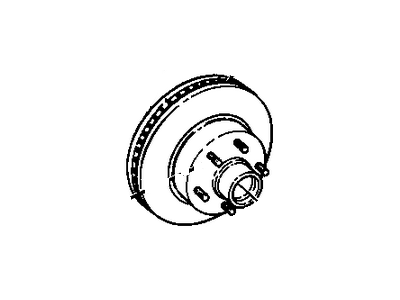
My Garage
My Account
Cart
Genuine Chevrolet C1500 Brake Disc
Disc Rotor- Select Vehicle by Model
- Select Vehicle by VIN
Select Vehicle by Model
orMake
Model
Year
Select Vehicle by VIN
For the most accurate results, select vehicle by your VIN (Vehicle Identification Number).
7 Brake Discs found
Chevrolet C1500 Brake Disc
The Brake Disc of Chevrolet C1500 cars is one of the subsystems of the disc brake system; its task is to create the required amount of friction for the brake, which is needed to slow and stop the car. Located on the wheel hub is the brake disc or rotor which similar to the brake drum operates with the brake pad and caliper. When the brakes are applied then hydraulic pressure squeezes the caliper putting pressure on the pads to press over the rotor and slows the vehicle. Chevrolet C1500 models have used a range of brake discs with time using both the solid and the vented rotors. As indicated, vented rotors are much superior to their counterparts, mainly because of their cooling fins as opposed to the block of solid rotors common in tiny non-performance automobiles. Also, the drilled or slotted discs enhance the vehicle's performance by facilitating the dissipation of heat and reduction of noise, but at the same time cause wear out of the pads. The braking system plays a critical role in the performance of the Chevrolet C1500.
Each OEM Chevrolet C1500 Brake Disc we offer is competitively priced and comes with the assurance of the manufacturer's warranty for the part. Furthermore, we guarantee the speedy delivery of your orders right to your doorstep. Our hassle-free return policy is also in place for your peace of mind.
Chevrolet C1500 Brake Disc Parts Questions & Experts Answers
- Q: How to inspect and replace brake discs on Chevrolet C1500?A:Loosen the wheel lug nuts, raise the front of the vehicle and support it securely on jackstands. Apply the parking brake. Remove the wheel. Remove the brake caliper. Visually inspect the disc surface for score marks and other damage. Light scratches and shallow grooves are normal after use and won't affect brake operation. Deep grooves-over 0.015-inch (0.38 mm) deep-require disc removal and refinishing by an automotive machine shop. Be sure to check both sides of the disc. To check disc run out, place a dial indicator at a point about 1/2-inch from the outer edge of the disc. On 4WD models, install two lug nuts, with the flat sides facing in, and tighten them securely to hold the disc in place. Set the indicator to zero and turn the disc. The indicator reading should not exceed 0.006-inch. If it does, the disc should be refinished by an automotive machine shop. Note: Professionals recommend resurfacing the brake discs regardless of the dial indicator reading. At the very least, if you elect not to have the discs resurfaced, deglaze them with sandpaper or emery cloth. The disc must not be machined to a thickness less than the specified minimum refinish thickness. The minimum (or discard) thickness is cast into the disc. The disc thickness can be checked with a micrometer. On 2WD models, the disc is an integral part of the front hub. Hub removal and installation is done as part of the front wheel bearing maintenance procedure. On all 4WD models (except one-ton [K-30] models) the disc can be pulled off the hub after the wheel and caliper have been removed. On one-ton [K-30] models, 4WD models, the disc is pressed on the hub and must be removed as a unit with the hub and bearing assembly. If replacement of the disc is necessary, take the assembly to an automotive repair shop to have the old disc pressed off and the new one pressed on.












